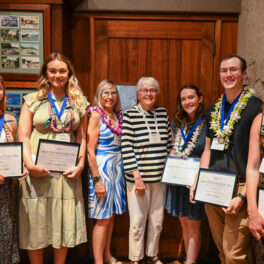The University of Hawaiʻi at Mānoa is highly ranked in a variety of subject areas, according to two of the premier comprehensive subject rankings in the world.
SOEST’s Department of Oceanography placed No. 7 in the U.S. and No. 17 in the world, the Department of Atmospheric Sciences ranked No. 10 in the U.S. and No. 13 in the world according to the 2023 Global Ranking of Academic Subjects (GRAS) released by the Shanghai Ranking Consultancy.
In total, 14 subjects at UH Mānoa placed in the top 1% in the world (top 250 out of more than 25,000 colleges and universities worldwide) in the GRAS. Additionally, in the Times Higher Education World University Rankings by Subject, released on October 26, five out of the 10 ranked UH Mānoa subjects placed in the world’s top 1% (within top 250 in the world), while four others placed in the world’s top 2% (within top 500).
“These rankings affirm our university’s commitment to excellence across a wide range of disciplines,” UH Mānoa Provost Michael Bruno said. “Our world-class faculty are working hard to prepare our students to be the creative and innovative leaders who will transform our islands and the world.”
Global Ranking of Academic Subjects
Fourteen UH Mānoa subjects were ranked by the Shanghai Ranking Consultancy, including four in the world’s top 100 and 11 in the nation’s top 70. GRAS, released on October 27, is considered one of the most comprehensive and objective rankings of world universities by subjects.
UH Mānoa was one of more than 1,900 universities in 104 countries and regions selected for the GRAS rankings, out of more than 25,000 total colleges and universities around the world. The criteria include research output, research influence, international collaboration, research quality and international academic awards.
UH Mānoa’s rankings:
– Atmospheric science: No. 13 worldwide, No. 10 U.S.
– Oceanography: No. 17 worldwide, No. 7 U.S.
– Hospitality and tourism management: No. 49 worldwide, No. 18 U.S.
– Earth sciences: No. 51–75 worldwide, No. 19–30 U.S.
– Public administration: No. 101–150 worldwide, No. 47–62 U.S.
– Communication: No. 101–150 worldwide, No. 47–63 U.S.
– Education: No. 101–150 worldwide, No. 68–84 U.S.
– Ecology: No. 151–200 worldwide, No. 43–60 U.S.
– Sociology: No. 151–200 worldwide, No. 72–87 U.S.
– Geography: No. 201–300 worldwide, No. 43–69 U.S.
– Biotechnology: No. 201–300 worldwide, No. 49–66 U.S.
– Environmental science and engineering: No. 201–300 worldwide, No. 53–67 U.S.
– Political science: No. 201–300 worldwide, No. 88–114 U.S.
– Agricultural sciences: No. 401–500 worldwide, No. 56–63 U.S.
Other rankings
UH Mānoa also received these notable rankings:
- 2024 Times Higher Education World University Rankings: UH Mānoa placed No. 57 in the U.S. and in the No. 201–250 tier worldwide September 27, 2023
- 2024 QS World University Rankings: UH Mānoa placed No. 66 in the U.S. and No. 386 in the world June 27, 2023
- Global 2000 list by the Center for World University Rankings: UH Mānoa came in at No. 137 in the U.S. and No. 505 in the world May 15, 2023
- 2023–24 U.S. News and World Report’s Best Graduate Schools rankings April 24, 2023
For more information, visit the Mānoa Institutional Research Office website.
Read more on UH News.











